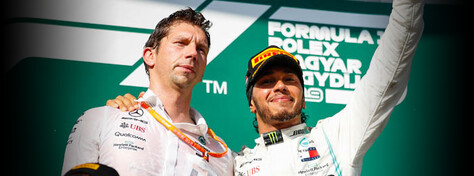Hungaroring
CIRCUIT PAGE
03/01/2022

CIRCUIT DIAGRAM

DETAILS
Hungaroring
Hungaroring Circuit
2146 Mogyorod
Pf. 10 Formula O ne KFT
ne KFT
Hungary
Tel: +36 28 444 444
Fax: +36 28 441 860
Official website:
www.hungaroring.hu
STATISTICS (PRIOR TO 2022)
Length:
4.381km (2.722miles)
Race laps:
70
2021 winner:
Esteban Ocon (Alpine)
Configuration:
Clockwise
First GP:
1986
Lap record:
1:16.627 (Hamilton, Mercedes, 2020)
Type:
Permanent Circuit
Total races:
35
BIOGRAPHY
Of all the countries in the former Easter Bloc, Hungary had the freest enterprise culture and the closest links with the West. It also had a motor racing pedigree which went back to a first Grand Prix run in 1906, while there had been racing in Budapest from 1926.
Bernie Ecclestone wanted a race in Russia, but a Hungarian friend recommended Budapest. Initially it was intended that a street circuit be built in the Nepliget, Budapest’s largest park, but the government decided on a purpose built new circuit just outside the city near a major highway. Construction work started in October 1985 and the circuit was built in eight months, less time than any other Formula One circuit.
Built with state backing, and laid out in a natural amphitheatre, the Hungaroring opened in 1986 and attracted an estimated 200,000 spectators.
Though the event was well-organised, and the hosts very appreciative, it was felt that the 2.494 mile circuit had been laid out more in the style of a twisty street circuit rather than a bespoke road track. There were few opportunities for overtaking, though things were eased from 1989 when a tight corner, the ‘Dirversion’ was by-passed and the lap distance became 2.466 miles.
In 2003 a number of modifications were carried out to the track including the lengthening of the start-straight by 202 metres.
However, in the opinion of many, year after year after year the Hungaroring continues to provide one of the most dismal, boring races of the season. This isn’t entirely down to the track, but also the ‘limitations’ of the new breed of F1 car, and indeed the sprint-stop-sprint limitations of the sport.
The Grand Prix is held in the middle of summer, which is usually hot and dry, indeed, the first wet Grand Prix wasn’t until 2006. The circuit is normally dusty due to underuse throughout the rest of the year and its sandy soil. As the circuit is in a valley about 80 percent of it can be seen from any point.
Normally an underused circuit becomes faster over the weekend as the track surface gathers more rubber residue; however, with the Hungaroring this generally does not happen because the track can get dusty so quickly. The track frequently becomes faster during a qualifying session, which leads competitors to try for their best lap as late as possible.
The twisty and bumpy nature of the circuit makes overtaking very difficult in dry conditions. Nonetheless, the Hungaroring has been the scene of several memorable races such as the duels of Nelson Piquet and Ayrton Senna, Nigel Mansell’s lost wheel in 1987, Mansell’s win from 12th on the grid after a dramatic pass on Ayrton Senna in 1989, Damon Hill’s almost victory with Arrows in 1997 and maiden wins for Hill in 1993, Fernando Alonso in 2003, Jenson Button in 2006 in the track’s first ever wet grand prix, and Heikki Kovalainen in 2008.


 ne KFT
ne KFT